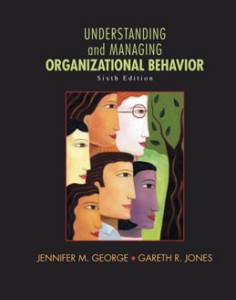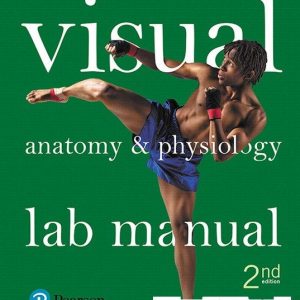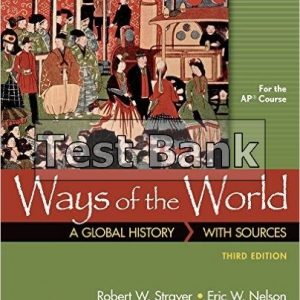This is completed downloadable of Test Bank for Understanding and Managing Organizational Behavior, 6th Edition: George

Product Details:
- ISBN-10 : 0136124496
- ISBN-13 : 978-0136124498
- Author:
This book makes an authoritative and practical introduction to organizational behavior. It contains leading-edge coverage of topics and issues combined with a wealth of learning tools that help readers experience Organizational Behavior and guide them to becoming better managers. Chapter topics discuss individual differences: personality, ability, and job performance; work values, attitudes, moods, and emotions; perception, attribution, and the management of diversity; learning and creativity at work; pay, careers, and changing employment relationships; managing stress and work-life linkages; leadership; power, politics, conflict, and negotiation; communication flows and information technology; organizational culture and ethical behavior; and organizational change and development . For business professionals preparing for a career in management.
Table of Content:
- Chapter 1 Introduction to Organizational Behavior
- Outline
- Learning Objectives
- Overview
- What is Organizational Behavior?
- The Nature of Organizational Behavior
- Levels of OB
- OB and Management
- Managerial Functions
- Planning
- Organizing
- Leading
- Controlling
- Managerial Roles
- Managerial Skills
- Challenges for OB
- Challenge 1: The Changing Social and Cultural Environment
- Developing Organizational Ethics and Well-Being
- Dealing with a Diverse Workforce
- Fairness and Justice Challenge
- Decision-Making and Performance Challenge
- Flexibility Challenge
- Challenge 2: The Evolving Global Environment
- Understanding Global Differences
- Global Learning
- Global Crisis Management
- Challenge 3: Advancing Information Technology
- IT and Organizational Effectiveness
- IT, Creativity, and Organizational Learning
- Challenge 4: Shifting Work and Employment Relationships
- Summary
- Exercises in Understanding and Managing Organizational Behavior
- Questions for Discussion and Review
- Key Terms in Review
- OB: Increasing Self-Awareness Behavior in Organizations
- A Question of Ethics Ethical versus Unethical Behavior
- Small Group Break-Out Exercise Identifying an Open System
- Topic for Debate
- Experiential Exercise Ethical Issues in Globalization
- Closing Case How Jeff Bezos Manages At Amazon.com
- Questions for Discussion
- F. W. Taylor and Scientific Management
- The Work of Mary Parker Follett
- The Hawthorne Studies and Human Relations
- Theory X and Theory Y
- Theory X
- Theory Y
- Part 1 Individuals in Organizations
- Chapter 2 Individual Differences: Personality and Ability
- Outline
- Learning Objectives
- Overview
- The Nature of Personality
- Determinants of Personality: Nature and Nurture
- Personality and the Situation
- Personality: A Determinant of the Nature of Organizations
- The Big Five Model of Personality
- Extraversion
- Neuroticism
- Agreeableness
- Conscientiousness
- Openness to Experience
- Conclusions
- Other Organizationally Relevant Personality Traits
- Locus of Control
- Self-Monitoring
- Self-Esteem
- Type A and Type B Personalities
- Needs for Achievement, Affiliation, and Power
- How Personality Is Measured
- The Nature of Ability
- Cognitive Ability
- Physical Ability
- Where Do Abilities Come from and How Are They Measured?
- Emotional Intelligence: A Different Kind of Ability
- The Management of Ability in Organizations
- Selection
- Placement
- Training
- Summary
- Exercises in Understanding and Managing Organizational Behavior
- Questions for Discussion and Review
- Key Terms in Review
- OB: Increasing Self-Awareness Characteristics of People and Jobs
- A Question of Ethics
- Questions
- Small Group Break-Out Exercise Understanding Situational Influences
- Topic for Debate
- Experiential Exercise Individual Differences in Teams
- Objective
- Procedure
- Closing Case Mark Wilson Creates a Different Kind of Telemarketer
- Questions for Discussion
- Chapter 3 Values, Attitudes, and Moods and Emotions
- Outline
- Learning Objectives
- Overview
- Values, Attitudes, and Moods and Emotions
- The Nature of Values
- Work values
- Ethical values
- The Nature of Work Attitudes
- The Nature of Moods and Emotions
- Relationships between Values, Attitudes, and Moods and Emotions
- Job Satisfaction
- Determinants of Job Satisfaction
- Personality
- Values
- The work situation
- Social influence
- Theories of Job Satisfaction
- The Facet Model of Job Satisfaction
- Herzberg’s Motivator-Hygiene Theory of Job Satisfaction
- The Discrepancy Model of Job Satisfaction
- The Steady-State Theory of Job Satisfaction
- Measuring Job Satisfaction
- Potential Consequences of Job Satisfaction
- Does Job Satisfaction Affect Job Performance?
- Absenteeism
- Turnover
- Organizational Citizenship Behavior
- Employee Well-Being
- Organizational Commitment
- Determinants of Affective Commitment
- Potential Consequences of Affective Commitment
- Summary
- Exercises in Understanding and Managing Organizational Behavior
- Questions for Discussion and Review
- Key Terms in Review
- OB: Increasing Self-Awareness Understanding Your Own Experience of Work
- A Question of Ethics
- Questions
- Small Group Break-Out Exercise Identifying Unethical behavior
- Topic for Debate
- Experiential Exercise Promoting Organizational Citizenship Behavior
- Objective
- Procedure
- Closing Case PAETEC’s Values Lead to a Satisfied and Committed Workforce
- Questions for Discussion
- Chapter 4 Perception, Attribution, and the Management of Diversity
- Outline
- Learning Objectives
- Overview
- The Nature of Perception
- Motivation and Performance
- Fairness and Equity
- Ethical Action
- Characteristics of the Perceiver
- Schemas: The Perceiver’s Knowledge Base
- Are schemas functional?
- Stereotypes: An example of a dysfunctional schema
- The Perceiver’s Motivational State
- The Perceiver’s Mood
- Characteristics of the Target and Situation
- Ambiguity of the Target
- Social Status of the Target
- Impression Management by the Target
- Information Provided by the Situation
- Standing Out in the Crowd: The Effects of Salience in a Situation
- Extreme evaluations
- Stereotyping
- Biases and Problems in Person Perception
- Primacy Effects
- Contrast Effects
- Halo Effects
- Similar-to-Me Effects
- Harshness, Leniency, and Average Tendency Biases
- Knowledge-of-Predictor Bias
- Attribution Theory
- Internal and External Attributions
- The fundamental attribution error
- Attributional Biases
- The actor–observer effect
- Self-serving attribution
- Effectively Managing a Diverse Workforce
- Securing Top-Management Commitment to Diversity
- Diversity Training
- Education
- Mentoring Programs
- Sexual Harassment
- Summary
- Exercises in Understanding and Managing Organizational Behavior
- Questions for Discussion and Review
- Key Terms in Review
- OB: Increasing Self-Awareness Understanding Perceptions and Attributions in Group Meetings
- A Question of Ethics
- Questions
- Small Group Break-Out Exercise Dealing with Salience
- Topic for Debate
- Experiential Exercise Managing Diversity
- Objective
- Procedure
- Closing Case Sodexo and Principle Financial Group Recognized for the Effective Management of Diversity
- Questions for Discussion
- Chapter 5 Learning and Creativity
- Outline
- Learning Objectives
- Overview
- The Nature of Learning
- Learning through Consequences
- Encouraging Desired Behaviors through Positive and Negative Reinforcement
- Identifying desired behaviors
- Positive reinforcement
- Negative reinforcement
- Using reinforcement appropriately
- Reinforcement schedules
- Shaping
- Discouraging Undesired Behaviors through Extinction and Punishment
- Extinction
- Punishment
- Organizational Behavior Modification
- Identify the behavior to be learned
- Measure the frequency of the behavior
- Analyze the antecedents and consequences of the behavior
- Intervene to change the frequency of the behavior
- Evaluate whether the intervention was successful in changing behavior
- Ethical Issues in OB MOD
- Learning from Others
- Learning on Your Own
- Beliefs about One’s Ability to Learn: The Role of Self-Efficacy
- Sources of Self-Efficacy
- Learning by Doing
- Continuous Learning through Creativity
- The Creative Process
- Characteristics of Employees That Contribute to Creativity
- Individual differences
- Task-relevant knowledge
- Intrinsic motivation
- Characteristics of the Organizational Situation That Contribute to Creativity
- Level of autonomy
- Form of evaluation
- Reward system
- Importance of a task
- The Interaction of Personality and Situational Factors
- The Learning Organization
- Summary
- Exercises in Understanding and Managing Organizational Behavior
- Questions for Discussion and Review
- Key Terms in Review
- OB: Increasing Self-Awareness Learning Difficult Behaviors
- A Question of Ethics
- Questions
- Small Group Break-Out Exercise Raising Self-Efficacy
- Topic for Debate
- Experiential Exercise Managing the Learning Process
- Objective
- Procedure
- Closing Case Continuous Learning and Innovation
- Questions for Discussion
- Chapter 6 The Nature of Work Motivation
- Outline
- Learning Objectives
- Overview
- What Is Work Motivation?
- Direction of Behavior
- Level of Effort
- Level of Persistence
- The Distinction Between Motivation and Performance
- Intrinsic and Extrinsic Motivation
- Theories of Work Motivation
- Need Theory
- Maslow’s Hierarchy of Needs
- Alderfer’s ERG Theory
- The Research Evidence
- Expectancy Theory
- Valence: How Desirable Is an Outcome?
- Instrumentality: What Is the Connection Between Job Performance and Outcomes?
- Expectancy: What Is the Connection Between Effort and Job Performance?
- The Combined Effects of Valence, Instrumentality, and Expectancy on Motivation
- Equity Theory
- Equity
- Inequity
- Ways to Restore Equity
- The Effects of Inequity and the Research Evidence
- Organizational Justice Theory
- Forms of Organizational Justice
- Consequences of Organizational Justice
- Summary
- Exercises in Understanding and Managing Organizational Behavior
- Questions for Discussion and Review
- Key Terms in Review
- OB: Increasing Self-Awareness Peak Motivation Experiences
- A Question of Ethics
- Questions
- Small Group Break-Out Exercise Promoting Procedural Justice
- Topic for Debate
- Experiential Exercise Motivating in Lean Economic Times
- Objective
- Procedure
- Closing Case Motivating Employees at the Sas Institute
- Questions for Discussion
- Chapter 7 Creating a Motivating Work Setting
- Outline
- Learning Objectives
- Overview
- Job Design: Early Approaches
- Scientific Management
- Job Enlargement and Job Enrichment
- Job Design: The Job Characteristics Model
- Core Job Dimensions
- The Motivating Potential Score
- Critical Psychological States
- Work and Personal Outcomes
- The Role of Individual Differences in Employees’ Responses to Job Design
- The Research Evidence
- Job Design: The Social Information Processing Model
- The Role of the Social Environment
- The Role of Past Behaviors
- Job Design Models Summarized
- Organizational Objectives
- Goal Setting
- What Kinds of Goals Lead to High Motivation and Performance?
- Why Do Goals Affect Motivation and Performance?
- Limits to Goal-Setting Theory
- Management by Objectives
- Goal Setting and Job Design as Motivation Tools
- Summary
- Exercises in Understanding and Managing Organizational Behavior
- Questions for Discussion and Review
- Key Terms in Review
- OB: Increasing Self-Awareness Extrinsic and Intrinsic Motivation
- A Question of Ethics
- Questions
- Small Group Break-Out Exercise The Power of Social Influence
- Topic for Debate
- Experiential Exercise Increasing Autonomy
- Objective
- Procedure
- Closing Case Motivating Employees at Google
- Questions for Discussion
- Chapter 8 Pay, Careers, and Changing Employment Relationships
- Outline
- Learning Objectives
- Overview
- Psychological Contracts
- Determinants of Psychological Contracts
- Direct communication
- Observation
- Written documents
- Types of Psychological Contracts
- Transactional contracts
- Relational contracts
- When Psychological Contracts Are Broken
- Performance Appraisal
- Encouraging High Levels of Motivation and Performance
- Providing Information for Decision Making
- Developing a Performance Appraisal System
- Choice 1: The mix of formal and informal appraisals
- Choice 2: What factors to evaluate
- Choice 3: Methods of appraisal
- Choice 4: Who appraises performance?
- Potential Problems in Subjective Performance Appraisal
- Pay and the Employment Relation
- Merit Pay Plans
- Should Merit Pay Be Based on Individual, Group, or Organizational Performance?
- Should Merit Pay Be in the Form of a Salary Increase or a Bonus?
- Examples of Merit Pay Plans
- The Ethics of Pay Differentials and Comparable Worth
- Careers
- The Nature of Careers
- Types of Careers
- Steady-state careers
- Linear careers
- Spiral careers
- Transitory careers
- Career Stages
- Preparation for work
- Organizational entry
- Early career
- Mid-career
- Late career
- Contemporary Career Challenges
- Ethical career management
- Career management that supports diversity
- Career management in an era of dual-career couples
- Summary
- Exercises in Understanding and Managing Organizational Behavior
- Questions for Discussion and Review
- Key Terms in Review
- OB: Increasing Self-Awareness Determining Career Aspirations and Goals
- A Question of Ethics
- Questions
- Small Group Break-Out Exercise When Performance Appraisals Seem Unfair
- Topic for Debate
- Experiential Exercise Designing Effective Performance Appraisal and Pay Systems
- Objective
- Procedure
- Closing Case Valuing Employees at Costco
- Questions for Discussion
- Chapter 9 Managing Stress and Work-Life Balance
- Outline
- Learning Objectives
- Overview
- The Nature of Stress
- Individual Differences and Stress
- Personality
- Ability
- Consequences of Stress
- Physiological consequences
- Psychological consequences
- Behavioral consequences
- Sources of Stress
- Personal Stressors
- Job-Related Stressors
- Group- and Organization-Related Stressors
- Stressors Arising Out of Work-Life Balance
- Environmental Uncertainty
- Coping with Stress
- Problem-Focused Coping Strategies for Individuals
- Time management
- Getting help from a mentor
- Role negotiation
- Emotion-Focused Coping Strategies for Individuals
- Exercise
- Meditation
- Social support
- Clinical counseling
- Nonfunctional strategies
- Problem-Focused Coping Strategies for Organizations
- Job redesign and rotation
- Reduction of uncertainty
- Job security
- Company day care and family friendly benefits
- Flexible work schedules and job sharing
- Telecommuting
- Emotion-Focused Coping Strategies for Organizations
- On-site exercise facilities
- Organizational support
- Employee assistance programs
- Personal days, time off, and sabbaticals
- Summary
- Exercises in Understanding and Managing Organizational Behavior
- Questions for Discussion and Review
- Key Terms for Review
- OB: Increasing Self-Awareness The Nature of Stressful Experiences
- A Question of Ethics
- Questions
- Small Group Break-Out Exercise Emotion-Focused Ways of Coping
- Topic for Debate
- Experiential Exercise Developing Effective Coping Strategies
- Objective
- Procedure
- Closing Case Stress and Burnout Among Entrepreneurs and the Self-Employed
- Questions for Discussion
- Part 2 Group and Team Processes
- Chapter 10 The Nature of Work Groups and Teams
- Outline
- Learning Objectives
- Overview
- Introduction to Groups
- Types of Work Groups
- Types of formal work groups
- Types of informal work groups
- Group Development Over Time: The Five-Stage Model
- Characteristics of Work Groups
- Group Size
- Group Composition
- Group Function
- Group Status
- Group Efficacy
- Social Facilitation
- How Groups Control Their Members: Roles and Rules
- Roles
- Written Rules
- How Groups Control Their Members: Group Norms
- Why Do Group Members Conform to Norms?
- Idiosyncrasy Credit
- The Pros and Cons of Conformity and Deviance
- Balancing Conformity and Deviance
- Ensuring that Group Norms are Functional for the Organization
- Socialization: How Group Members Learn Roles, Rules, and Norms
- Socialization and Role Orientation
- Socialization Tactics
- Collective versus individual tactics
- Formal versus informal tactics
- Sequential versus random tactics
- Fixed versus variable tactics
- Serial versus disjunctive tactics
- Divestiture versus investiture tactics
- Summary
- Exercises in Understanding and Managing Organizational Behavior
- Questions for Discussion and Review
- Key Terms for Review
- OB: Increasing Self-Awareness Analyzing a “Real” Group
- A Question of Ethics
- Questions
- Small Group Break-Out Exercise Encouraging Dissenting Views
- Topic for Debate
- Experiential Exercise Developing Roles, Rules, and Norms
- Objective
- Procedure
- Closing Case Teams Fuel Global Innovation at Whirlpool
- Questions for Discussion
- Chapter 11 Effective Work Groups and Teams
- Overview
- Learning Objectives
- Overview
- Process Losses, Process Gains, and Group Effectiveness
- Potential Performance?
- Process Losses and Performance
- Process Gains and Performance
- Social Loafing: A Problem in Group Motivation and Performance
- Group Size and Social Loafing
- Ways to Reduce Social Loafing
- Making individual contributions identifiable
- Make individuals believe they provide a valuable contribution to a group
- Keeping the group as small as possible
- How Task Characteristics Affect Group Performance
- Pooled Interdependence
- Sequential Interdependence
- Reciprocal Interdependence
- Group Cohesiveness and Performance
- Factors that Contribute to Group Cohesiveness
- Group size
- Similarity/diversity of group members
- Competition between groups
- Success
- Exclusiveness
- Consequences of Group Cohesiveness
- Consequences when group goals are aligned with organizational goals
- Consequences when group goals are not aligned with organizational goals
- Important Organizational Groups
- The Top Management Team
- Self-Managed Work Teams
- Research and Development Teams
- Virtual Teams
- Summary
- Exercises in Understanding and Managing Organizational Behavior
- Questions for Discussion and Review
- Key Terms in Review
- OB: Increasing Self-Awareness Group Effectiveness
- A Question of Ethics
- Group Processes and Ethics
- Small Group Break-Out Exercise When and How to Use Groups
- Topic for Debate
- Experiential Exercise Curtailing Social Loafing
- Objective
- Procedure
- Closing Case Why Microsoft’s Measurement System Led to Problems with Group Performance
- Questions for Discussion
- Chapter 12 Leaders and Leadership
- Outline
- Learning Objectives
- Overview
- Introduction to Leadership
- Early Approaches to Leadership
- The Leader Trait Approach
- The Leader Behavior Approach
- Consideration
- Initiating structure
- The Behavior Approach: Leader Reward and Punishing Behavior
- Measuring Leader Behaviors
- What Is Missing in the Trait and Behavior Approaches?
- Fiedler’s Contingency Theory of Leadership
- Leader Style
- Situational Characteristics
- Leader–member relations
- Task structure
- Position power
- The Contingency Model
- Contemporary Perspectives on Leadership
- Path-Goal Theory: How Leaders Motivate Followers
- The Vroom and Yetton Model: Determining the Level of Subordinate Participation in Decision Making
- Leader–Member Exchange Theory: Relationships Between Leaders and Followers
- Does Leadership Always Matter in Organizations?
- Leadership Substitutes
- Leadership Neutralizers
- The Romance of Leadership
- New Topics in Leadership Research
- Transformational and Charismatic Leadership
- Leader Mood
- Gender and Leadership
- Ethical Leadership
- Recap of Leadership Approaches
- Summary
- Exercises in Understanding and Managing Organizational Behavior
- Questions for Discussion and Review
- Key Terms for Review
- OB: Increasing Self-Awareness Contemporary Leaders
- A Question of Ethics Influence at Work
- Small Group Break-Out Exercise A Leadership Problem at HighandTall
- Topic for Debate
- Experiential Exercise Effectively Leading a Work Group
- Objective
- Procedure
- Closing Case Tammy Savage and the NETGENeration
- Questions for Discussion
- Chapter 13 Power, Politics, Conflict, and Negotiation
- Outline
- Learning Objectives
- Overview
- The Nature of Power and Politics
- Sources of Individual Power
- Sources of Formal Individual Power
- Legitimate power
- Reward power
- Coercive power
- Information power
- Sources of Informal Individual Power
- Expert power
- Referent power
- Charismatic power
- Sources of Functional and Divisional Power
- Ability to Control Uncertain Contingencies
- Irreplacability
- Centrality
- Ability to Control and Generate Resources
- Organizational Politics: The Use of Power
- Tactics for Increasing Individual Power
- Tapping the sources of functional and divisional power
- Recognizing who has power
- Controlling the agenda
- Bringing in an outside expert
- Building coalitions and alliances
- Managing Organizational Politics
- What Is Organizational Conflict?
- Sources of Organizational Conflict
- Differentiation
- Differences in functional orientations
- Status inconsistencies
- Task Relationships
- Overlapping authority
- Task interdependencies
- Incompatible evaluation systems
- Scarcity of Resources
- Pondy’s Model of Organizational Conflict
- Latent Conflict
- Perceived Conflict
- Felt Conflict
- Manifest Conflict
- Conflict Aftermath
- Negotiation: Resolving Conflict
- Individual-Level Conflict Management
- Group-Level Conflict Management
- Promoting Compromise
- Emphasize common goals
- Focus on the problem, not the people
- Focus on interests, not demands
- Create opportunities for joint gain
- Focus on what is fair
- Union–management negotiations
- Summary
- Exercises in Understanding and Managing Organizational Behavior
- Questions for Discussion and Review
- Key Terms in Review
- OB: Increasing Self-Awareness Understanding Conflict and Politics
- A Question of Ethics
- Power, Politics, and Negotiation
- Small Group Break-Out Exercise What Are the Sources of Conflict?
- Topic for Debate
- Experiential Exercise Managing Conflict Successfully
- Objective
- Procedure
- Closing Case Mixing Business and Family Causes Conflict
- Questions for Discussion
- Chapter 14 Communicating Effectively in Organizations
- Outline
- Learning Objectives
- Overview
- What Is Communication?
- The Functions of Communication
- Providing knowledge
- Motivating organizational members
- Controlling and coordinating group activities
- Expressing feelings and emotions
- Communication Networks in Organizations
- Group communication networks
- Organizational communication networks
- The Communication Process
- The Sender and the Message
- Encoding
- Jargon
- The Medium
- Verbal communication
- Nonverbal communication
- The Receiver: Decoding and the Feedback Loop
- Barriers to Effective Communication
- Filtering and Information Distortion
- Poor Listening
- Lack of or Inappropriate Feedback
- Rumors and the Grapevine
- Workforce Diversity
- Differences in Cross-cultural Linguistic Styles
- Selecting an Appropriate Communication Medium
- Information Richness
- Face-to-face communication
- Verbal communication electronically transmitted
- Personally addressed written communication
- Impersonal written communication
- Trade-Offs in the Choice of Media
- Using Advanced IT
- Internet and Intranet applications
- Persuasive Communication
- A Model of Persuasive Communication
- Characteristics of the sender
- Active listening
- Method of communication
- Characteristics of the receiver
- Communication in Crisis Situations
- Summary
- Exercises in Understanding and Managing Organizational Behavior
- Questions for Discussion and Review
- Key Terms in Review
- OB: Increasing Self-Awareness Effective and Ineffective Communication
- A Question of Ethics
- Small Group Break-Out Exercise
- Implementing IT in a Medical Clinic
- Topic for Debate
- Experiential Exercise
- Troubling Communication
- Objective
- Procedure
- Closing Case How Chrysler’s Tom LaSorda learned how to Talk to Employees
- Questions for Discussion
- Chapter 15 Decision Making and Organizational Learning
- Outline
- Learning Objectives
- Overview
- Types of Decisions
- Nonprogrammed Decisions
- Programmed Decisions
- Ethical Decision Making
- The Decision-Making Process
- The Classical Model of Decision Making
- March and Simon’s Administrative Model of Decision Making
- Satisficing
- Bounded rationality
- Sources of Error in Decision Making
- Heuristics and Their Effects
- Availability heuristic
- Representativeness heuristic
- Anchoring and adjustment heuristic
- Escalation of Commitment
- The Role of Information Technology
- Group Decision Making
- Advantages of Group Decision Making
- Availability and diversity of members’ skills and knowledge
- Enhanced memory for facts
- Capability of error detection
- Greater decision acceptance
- Disadvantages of Group Decision Making
- Time needed to make a decision
- The potential for groupthink
- Other Consequences of Group Decision Making
- Diffusion of responsibility
- Group polarization
- Potential for conflict
- Decision Making in Crisis Situations
- Group Decision-Making Techniques
- Brainstorming
- The Nominal Group Technique
- The Delphi Technique
- Group Decision-Making Techniques Used in Total Quality Management
- Benchmarking
- Empowerment
- Organizational Learning
- Types of Organizational Learning
- Principles of Organizational Learning
- Personal mastery
- Complex mental models
- Team learning
- Building a shared vision
- Systems thinking
- Leadership and Learning
- Summary
- Exercises in Understanding and Managing Organizational Behavior
- Questions for Discussion and Review
- Key Terms in Review
- OB: Increasing Self-Awareness
- Analyzing Individual and Group Decisions
- A Question of Ethics
- Small Group Break-Out Exercise
- Brainstorming
- Topic for Debate
- Experiential Exercise
- Using the Nominal Group Technique
- Objective
- Procedure
- Closing Case Turnaround Decision Making at Liz Claiborne
- Questions for Discussion
- Part 3 Organizational Processes
- Chapter 16 Organizational Design and Structure
- Outline
- Learning Objectives
- Overview
- Designing Organizational Structure
- The Organizational Environment
- Technology
- Human Resources and the Employment Relationship
- Organic and Mechanistic Structures
- Grouping Jobs into Functions and Divisions
- Functional Structure
- Advantages of a functional structure
- Coordination advantages
- Motivational advantages
- Disadvantages of a functional structure
- Divisional Structures: Product, Market, and Geographic
- Product structure
- Market structure
- Geographic structure
- Advantages of a Divisional Structure
- Coordination advantages
- Motivational advantages
- Disadvantages of a Divisional Structure
- Matrix Structure
- Coordination advantages
- Motivational advantages
- Disadvantages of a matrix structure
- Summary
- Coordinating Functions and Divisions
- Allocating Authority
- Tall and flat hierarchies
- The minimum chain of command
- Centralization versus decentralization
- Mutual Adjustment and Integrating Mechanisms
- Direct contact
- Liaison roles
- Teams and task forces
- Cross-functional teams
- Standardization
- Standardizing inputs
- Standardizing Outputs
- New IT-Enabled Forms of Organizational Design and Structure
- The Effects of IT Inside Organizations
- The Effects of IT Between Organizations
- Summary
- Exercises in Understanding and Managing Organizational Behavior
- Questions for Discussion and Review
- Key Terms in Review
- OB: Increasing Self-Awareness
- Understanding Organizational Structure
- A Question of Ethics
- How to Lay Off Employees
- Small Group Break-Out Exercise
- Speeding Up Website Design
- Topic for Debate
- Experiential Exercise
- Analyzing Organizational Structure
- Objective
- Procedure
- Closing Case Home Depot’s Military-Style Structure
- Questions for Discussion
- Chapter 17 Organizational Culture and Ethical Behavior
- Outline
- Learning Objectives
- Overview
- What Is Organizational Culture?
- How Is an Organization’s Culture Transmitted to Its Members?
- Socialization and Socialization Tactics
- Stories, Ceremonies, and Organizational Language
- Factors Shaping Organizational Culture
- Characteristics of People Within the Organization
- Organizational Ethics
- Societal ethics
- Professional ethics
- Individual ethics
- The Employment Relationship
- Organizational Structure
- Adaptive Cultures versus Inert Cultures
- Traits of Strong, Adaptive Corporate Cultures
- Values from the National Culture
- Hofstede’s Model of National Culture
- Individualism versus collectivism
- Power distance
- Achievement versus nurturing orientation
- Uncertainty avoidance
- Long-term versus short-term orientation
- Creating an Ethical Culture
- Why Does Unethical Behavior Occur?
- Lapses in individual ethics
- Ruthless pursuit of self-interest
- Outside pressure
- Ways to Create an Ethical Culture
- Summary
- Exercises in Understanding and Managing Organizational Behavior
- Questions for Discussion and Review
- Key Terms in Review
- OB: Increasing Self-Awareness Understanding Culture
- A Question of Ethics When Is Culture Too Strong?
- Small Group Break-Out Exercise Developing a Service Culture
- Experiential Exercise A Culture Problem at High and Tall
- Closing Case Why 3M has an Innovative Culture
- Questions for Discussion
- Chapter 18 Organizational Change and Development
- Outline
- Learning Objectives
- Overview
- Forces for and Resistance to Organization Change
- Forces for Change
- Competitive forces
- Economic, political, and global forces
- Demographic and social forces
- Ethical forces
- Impediments to Change
- Organization-Level Resistance to Change
- Group-Level Resistance to Change
- Group norms
- Group cohesiveness
- Groupthink and escalation of commitment
- Individual-Level Resistance to Change
- Uncertainty and insecurity
- Selective perception and retention
- Habit
- Lewin’s Force-Field Theory of Change
- Evolutionary and Revolutionary Change in Organizations
- Evolutionary Change I: Sociotechnical Systems Theory
- Evolutionary Change II: Total Quality Management
- Revolutionary Change I: Reengineering
- E-Engineering
- Revolutionary Change II: Restructuring
- Revolutionary Change III: Innovation
- Managing Change: Action Research
- Diagnosis of the Organization
- Determining the Desired Future State
- Implementing Action
- Evaluating the Action
- Institutionalizing Action Research
- Organization Development
- OD Techniques to Deal with Resistance to Change
- Education and communication
- Participation and empowerment
- Facilitation
- Bargaining and negotiation
- Manipulation
- Coercion
- OD Techniques to Promote Change
- Counseling, sensitivity training, and process consultation
- Team building and intergroup training
- Total organizational interventions
- Summary
- Exercises in Understanding and Managing Organizational Behavior
- Questions for Discussion and Review
- Key Terms in Review
- OB: Increasing Self-Awareness Coping with Change
- A Question of Ethics Managing the Change Process
- Small Group Break-Out Exercise Practicing Kaizen
- Topic for Debate
- Experiential Exercise Analyzing Forces for and Impediments to Change
- Objectives
- Procedure
- Closing Case How United Technologies Manages the Change Process
- Questions for Discussion
- Appendix Research Methods in Organizational Behavior
- Overview
- The Scientific Process
- Coming Up With General Explanations: The Role of Theory Building
- Developing Specific Predictions: Formulating Hypotheses
- Testing Hypotheses: Operationalizing Variables
- Research Designs
- Tradeoffs in the Choice of Research Designs
- Ethical Considerations in Organizational Behavior Research
- Glossary
- References
- Name Index
- A
- B
- C
- D
- E
- F
- G
- H
- I
- J
- K
- L
- M
- N
- O
- P
- Q
- R
- S
- T
- U
- V
- W
- Y
- Z
- Company Index
- A
- B
- C
- D
- E
- F
- G
- H
- I
- J
- K
- L
- M
- N
- O
- P
- Q
- R
- S
- T
- U
- V
- W
- X
- Y
- Z
- Subject Index
- A
- B
- C
- D
- E
- F
- G
- H
- I
- J
- K
- L
- M
- N
- O
- P
- Q
- R
- S
- T
- U
- V
- W
- Z





